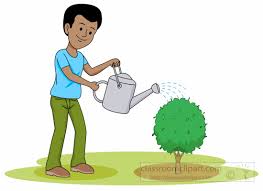
The happy gardener. You see him/her everywhere; on TV, on bill boards in magazines. And its mostly a very happy and content looking person watering plants with a hose or a watering can. And the water falling on the plants in an almost poetic manner with shower like effect. The image conveys the beauty and happiness involved in gardening (and sometimes it is also to sell some gardening equipment). Most gardeners I have met tend to water their plants in this popular way as it feels and looks really nice as per them. Unfortunately this is exactly how you should NOT water plants in pots or in garden. This post is a guide on How Not to and How to Water Plants in Pots. Though I’ll stick to container gardening, the same is applicable to all gardens.
Where you should Water your Plants
-
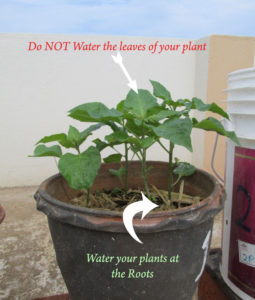
Water plants at roots; Not on leaves. While it is okay to ‘bathe’ your plants once in a while to remove off the dust from leaves, it is not okay to water your plants on the leaves. Plants need water at their roots and not on the leaves. The roots pull moisture from the soil and through capillary action send it to the leaves. So you should help plants by watering at the roots. Moreover moisture on the leaves if left overnight can cause fungal attack. Hence avoid wetting leaves of the plant while watering.
- Generally the branch roots of a plant (the ones that suck moisture and nutrients for the leaves) spread out to all directions. Water needs to be given to this system and not at the base of the plant. Watering at the base of the main trunk of the plant will loosen the grip of the plant in the soil. Hence water away from the base of the plant. You can water along the rim of the container for most effective watering. Generally the canopy of the plant gives an idea of its root systems. So while watering plants outside, you can follow the spread of the canopy and water around it’s projection on the ground if you your plant is on the ground.
When to Water your Plants
- Water early in the morning or late in the afternoon (if not possible in the morning). Watering in the morning makes sure that the plant has enough moisture to be used throughout the day. If by any chance you are unable to water in the morning, water your plants late in the afternoon. It should not be too hot when you are watering in the afternoon. At the same time there should be enough time for leaves to dry off in case they get wet. Never water your plants when the sun is over your head. Heat leads to excess water evaporation.
- Water only when soil dries out. Don’t water for the sake of it. To check if
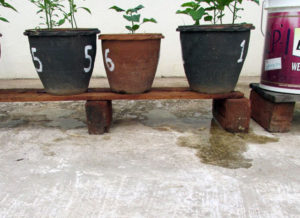
Excess watering causes nutrient leaching you need to water your plants you can put a finger inside the soil. If you feel the moisture, then there is no need to water the plants. Excess watering will lead to nutrient loss and also water loss.
- Sometimes in summers you’ll notice drooping leaves during the day time. Don’t rush to water your plant in such a case. Do the moisture test with your finger. Water only if the moisture has dried out. Otherwise just leave the plant. The leaves will spring back to life when the sun goes down. Drooping leaves result due to faster evaporation from leaves than the amount of moisture the roots can pump to it.
How to Water your Plants
-

Ganga flowing to earth through the matted hair of Lord Shiva Water your pots to make the soil moist and not dripping wet. Not only its a criminal waste of water, too much water in the pot can lead to root rot if the soil or your potting mix is not a well drained one. On regular observation you’ll be able to figure out the water requirement of each pot. Water accordingly. Over watering also leads to leaching or wastage of nutrients.
- Water with as less force as possible. It is best to just take a watering pipe with almost no force in the flow of the water and place it in your pot along the rim. Water jet disturbs the soil.
- Lastly on to some mythology. Though I am supposed to write about How to water plants in pots, you must be wondering why I am suddenly diverting to mythology. Well just read on to find out. In Indian mythology there is a story of the great river Ganga coming
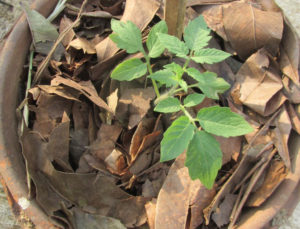
Use thick layer of mulch to arrest speed of water down from the heavens to the earth. But her force is so much that it would destroy the earth. So the great yogi Shiva uses his matted hair to arrest the force of the river Ganga coming down from the heavens. And that is exactly what you have to do by using a thick layer of mulch. Mulch helps in arresting the speed of the water falling on the base of your plants. Hence mulch your pots well. The other thing about mulch is that it catches the dew at night and when the dew condenses it flows down to the soil. Hence mulching also acts like a automatic watering system.
Water is an important natural resource and hence you should always aim to conserve it. Use as much surface water as possible and conserve ground water. Harvest rainwater, reuse domestic waste water (water in which vegetables have been washed). And most importantly water correctly and water efficiently. You not only conserve water, you also keep your soil and plants healthy and happy.


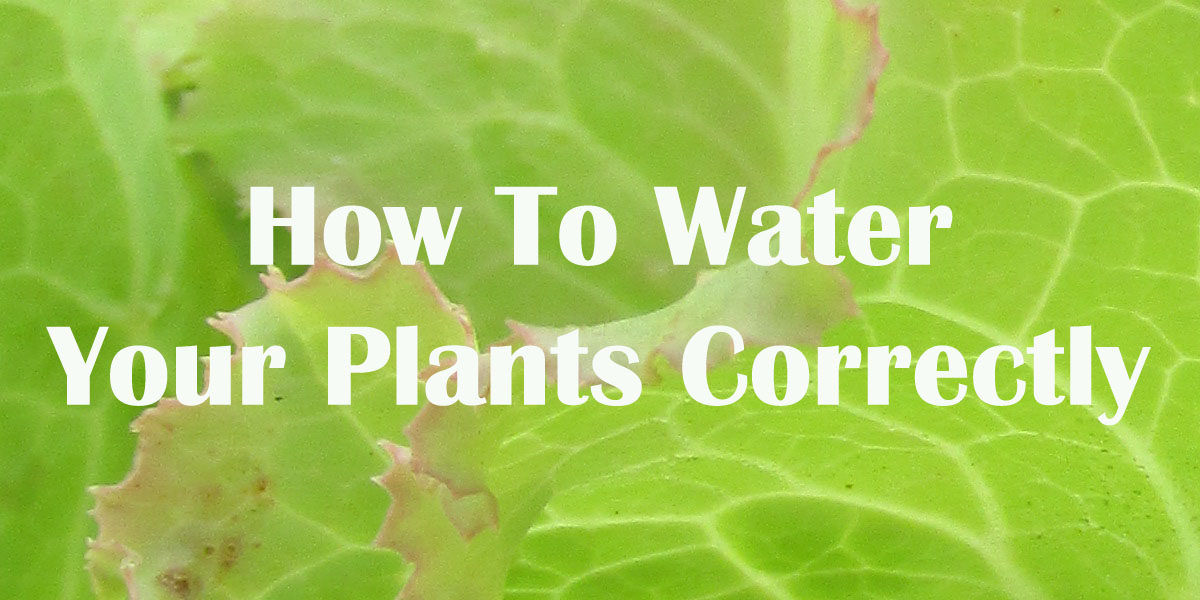
Very useful and genuine tips of watering the plants. We tend to miss out many basics by being over enthusiastic. Write-up is beautiful and I think it will be helpful to many of my fellow gardeners.
Thanks
Regards,
Thank you for your kind comment M R Guru Prasad.
Very useful and constructive tips. I have started terrace garden six month before. I have planted spinach. Capsicum and cucumber. Till three month ago there was not a single fruit on capsicum and cucumber. Now, after monsoon rain a lot of capsicum, baby one are seen. Can anyone guide when to pluck them.
When capsicum is mature you can pluck them by hand. They would come off if you bend them a little away from the stem. Else you can use a garden scissor.
This is really an eye-opener for people like me. People who are new to gardenning just start off without much knowledge.
In this sense your blog is unique as it provides genuine information to people/
Thank you
Very informative.Thanks a lot.
You are welcome